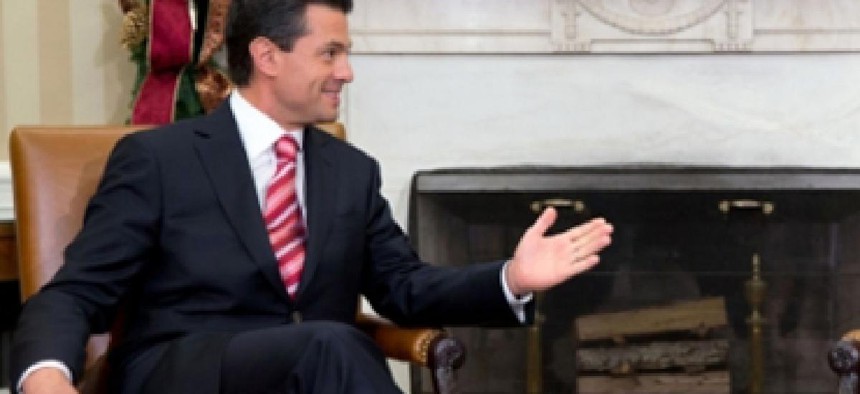Some cultural observations in Mexico

Mexico is one of just a few countries that has successfully evolved from single-party rule to a democracy, Steve Kelman learns.

Mexican President Enrique Peña Nieto, shown during a meeting with President Barack Obama. (White House photo)
This has been a fascinating trip, and, beneath our preoccupations as Americans with drug violence and immigration, this is a fascinating society.
Of many observations, I offer here two historical ones and two about current issues.
I am really struck by the huge difference in the relationship between European colonizers (Spanish) and native peoples in Mexico versus the US. In Mexican high school history books, the Spanish settlement is referred to as The Conquest (La Conquista), and the history of the period is written from the Native people point of view. Why the enormous difference with the US? First, there were rather few Spanish settlers, and they came mostly to plunder or search for gold. They employed the natives, in semi-slave conditions, in mines and on enormous farms.
This is in stark contrast to the English settlers in North America, who were larger in number, came to work for themselves, and basically segregated themselves from Native Americans. Relatedly, almost all Spanish settlers were men, meaning there was frequent intermarriage, making most Mexicans of mixed origins. Today, there is in Mexico a pretty strong correlation between skin color and economic class, but in official discussions Mexicans seem to try to avoid discussions of race (though they do talk a lot about poverty). But it seems to me that this issue is there, somewhat strangely under the surface – a former student of mine, very white but with dark hair, told me that Mexicans with darker skins sometimes call her “blondie.”
Second, Mexico is one of the small number of countries that have peacefully and gradually transitioned from one-party rule into a functioning democracy. For decades, the PRI (Institutional Revolutionary Party), which grew out of the Mexican Revolution of 1910, ruled the country with a mixture of leftist, nationalist ideology and a practice featuring extensive corruption and close ties with the country’s economic elite. (This is very similar to the Communist Party of China.) But, as a result of a series of economic problems and the growth of education, the PRI’s grip on the country gradually, step by step, diminished – elections and the media became freer, genuine opposition parties emerged – until the opposition came to power peacefully in 2000, was re-elected once, and then was defeated in this year’s presidential election, bringing the PRI back to power.
Move to the present. There are very important economic developments taking place in Mexico that are getting far too little attention in the US. The rise of wages in China and the closeness of Mexico to the US market are leading many large multinational companies to redirect investment from China (or elsewhere in Asia) to Mexico. The increased Mexican prosperity that is coming out of this is good for the US, both because Mexico is a large export market for us and also because it creates less desperation-driven emigration. But strategically, a new pattern is beginning – of products that are produced partly in Mexico and partly in the US, going back and forth across the border. If this trend continues, it could be a very important part of “onshoring,” the return of parts of American industry to the US. Often, total production in the US is not economical, but partial production is. With luck, we will be seeing more of this – especially if some of the cross-border trucking issues (trucks must often unload and reload into US trucks on crossing the US border) can be resolved.
The newly elected Mexican president, Enrique Peña Nieto, just took office. He has made noise about taking on some of the tough interest group challenges that face Mexico. These prominently include lack of competition in important sectors of the Mexican economy, particularly telecoms (dominated by Carlos Slim, who, depending on the year, is the richest man in the world), and a poorly functioning primary/secondary education system (dominated by a strong teachers union, which often makes hiring decisions and allows teaching jobs to be literally passed on from parents to their children). Both of these problems are inhibitors to Mexican economic development. But they both involve powerful actors who have historically been close to the PRI. Whether Peña Nieto will be able to pull off an “only Nixon can go to China” moment will be the big question mark of the next few years.





